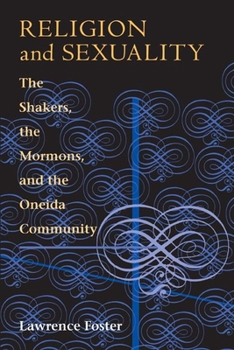Religion and Sexuality: The Shakers, the Mormons, and the Oneida Community
Select Format
Select Condition 
Book Overview
"Most writers have treated these three groups and the social ferment out of which they grew as simply an American sideshow. . . . In this book, therefore, I have attempted to go beyond the conventional focus on what these groups did; I have also sought to explain why they did what they did and how successful they were in terms of their own objectives. By trying sympathetically to understand these extraordinary experiments in social and religious revitalization, I believe it is possible to come to terms with a broader set of questions that affect all men and women during times of crisis and transition."--From the preface Winner of the Best Book Award, Mormon History Association
Format:Paperback
Language:English
ISBN:0252011198
ISBN13:9780252011191
Release Date:March 1984
Publisher:University of Illinois Press
Length:384 Pages
Weight:1.19 lbs.
Dimensions:0.8" x 6.2" x 8.9"
Customer Reviews
1 rating
What do the Mormons, the Shakers, and the Oneida Perfectionists have in common?
Published by Thriftbooks.com User , 19 years ago
The answer is quite a lot, according to historian Lawrence Foster, a member of the history faculty at Georgia Tech, a former president of the Mormon History Association, and a longstanding friend and colleague in the study of the Mormon past. Foster begins his discussion of the marriage practices of these three groups by focusing on the larger milieu of antebellum American society. During that era virtually all of the institutions of humankind received serious scrutiny and some alteration. The most obvious example was the abolition of slavery in much of the Western World; of course it came to an end in the United States only because of the radical realignment of political power coming through the Civil War. But other institutions such as marriage and family patterns also found their critics and experimenters abounded. Some of those alterations led to the creation of the Victorian family so elegantly described in a succession of books on the subject such as in "Cradle of the Middle Class: The Family in Oneida County, New York, 1790-1865" (Cambridge University Press, 1981) by Mary P. Ryan. This book explores Mormon plural marriage, Shaker celibacy, and Oneida Perfectionist group marriage as it originated and evolved in the nineteenth century. Foster treats these experiments in marriage and family not as aberrations from a well=established norm, but as legitimate permutations of the reform impulse of the era. Each of these groups was founded by a charismatic leader, and Foster spends considerable energe probing the mind of Josepm Smith, ann Lee, and John Humphery Noyes. In the process he substantially illuminates the groups he focuses on, helps explain their marriage practices, and draws interesting comparisons between them. In this latter regard, especially, Foster's concluding chapter is a welcome addition to the literature, addressing such issues as the role of women in these various groups, the concept of religious authority and power and who has it and why, and family and childrearing practices. Foster takes a heavily anthropological approach toward his work, and theories ranging from Arnold Van Gennep to Victor Turner abound. He is intrigued by rituals, and by "rites of passage" ceremonial practices. This is an exceptionally fine study that holds a central place in the historiogtraphy of the Mormon religion. Enjoy!





